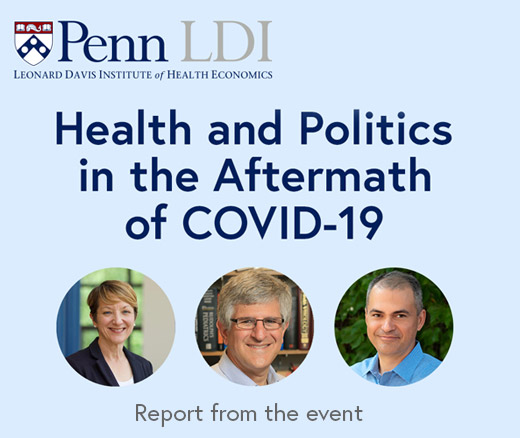
Cash Transfers and Healthy Birth Outcomes
Promising New Evidence and What’s Next
Population Health
Blog Post

During the COVID-19 pandemic, the amount of public health information reached unprecedented levels. From daily updates on new cases in local communities to fluctuations in infections, as well as changing guidelines on mask-wearing, individuals were inundated with information. Despite the abundance of pandemic-related statistics, little work has been done to understand how the public responds to these communications.
In groundbreaking research, LDI Senior Fellow Dolores Albarracín and Annie Jung from the University of Pennsylvania Annenberg School for Communication’s Social Action Lab answered the question: How do people use information about changes in COVID-19 infections and prevalence? With a strong record in understanding the basic principles underlying the impact of persuasive communications and promoting health behavior, they evaluated whether public health communications during the COVID-19 pandemic effectively produced behavioral change. In addition to this work, their research team has recently published several papers on the efficacy of vaccination policies, altruistic motives for vaccination, combating health misinformation, and more.
Using COVID-19 as a case study, the researchers examined two approaches to delivering public health information: absolute risk and changes in risk. Absolute risk, represented by overall disease prevalence, informs individuals about their daily risk of contracting a disease. On the other hand, communicating changes adds context to the information, although the context can be misleading. For instance, if you were informed that you have a 30% chance of getting a sunburn today, you might continue with your day. However, if you were told that you are 30% more likely to get a sunburn today compared to yesterday, you would likely modify your behavior to protect yourself better.
I sat with Albarracín and Jung to understand their study and its implications on public health communications moving forward.
Jung: Our paper demonstrates that when evaluating the risk of contracting an illness, people use “change” information, which tells them whether their risk of getting infected has increased or decreased compared to yesterday or last week, more than absolute information–such as the number of people infected in a region.
An example of this, as stated above, is that people’s intentions to engage in preventive behavior are higher when they learn , “You have a 30% higher chance of getting a disease compared to yesterday,” compared to, “You have a 30% risk of getting a disease.”
Jung: Despite the flood of health information during the first three years of the pandemic, relatively little work has examined the public’s receptivity to change-risk information and how much they use it to guide health decisions, including those about mask-wearing, social distancing, and vaccination. Our study is the first to explore the influence of two ways–(a) changes in new infections and (b) number of infections or disease prevalence–that disease risk is communicated to the public by information outlets like the Centers for Disease Control and Prevention (CDC), the New York Times, and many more. Our work demonstrated that an increase or decrease in new infections influences people’s risk judgments and prevention decisions more than information about prevalence. This is new.
Albarracín: When you want people to take prompt action, emphasize change in risk. Additionally, communicators should provide a reference point that allows people to judge prevalence and explicitly discourage attention to only changes.
Albarracín: For public health risks, such as environmental hazards and violence, if you want community action, you should emphasize aspects of the issue that have deteriorated. But if you want the community’s actions to accurately reflect the risk, communications should de-emphasize change and promote understanding of absolute risk. Otherwise, when the risk decreases, people take less action, even when the risk is sky high. We, as communicators, need to establish metrics of what are acceptable and objective goals, so risk can be portrayed to the public in a consistent way.
As the pandemic falls off the front pages of newspapers and media outlets, researchers and policymakers are left to grapple with how to mobilize the lessons we have learned. When the next pandemic, natural resource crisis, or climate-related catastrophe emerges, communicators need to be able to provide timely and effective messaging to the public. Having the skills to cut through misinformation and potentially tense political landscapes will empower communities and individuals to stay healthy and safe.
The study, “How People Use Information About Changes in Infections and Disease Prevalence,” was published on February 2, 2023 in Health Psychology. Authors include Annie Jung and Dolores Albarracín.


Promising New Evidence and What’s Next

From 1990 to 2019, Black Life Expectancy Rose Most in Major Metros and the Northeast—but Gains Stalled or Reversed in Rural Areas and the Midwest, Especially for Younger Adults

A Penn LDI Seminar Focuses on Why They’re Important for the Future

Former Philadelphia Health Commissioner Warns That Gutting the CDC, Undermining Vaccines, and Politicizing Science Will Leave the U.S. Dangerously Unprepared for the Next Pandemic

Rural Parents Had More Emergency Visits and Insurance Loss Than Urban Peers, an LDI Study Shows. Integrated Baby Visits Could Help All Parents Be Healthier

From Anxiety and Loneliness to Obesity and Gun Deaths, a Sweeping New Study Uncovers a Devastating Decline in the Health and Well-Being of U.S. Children